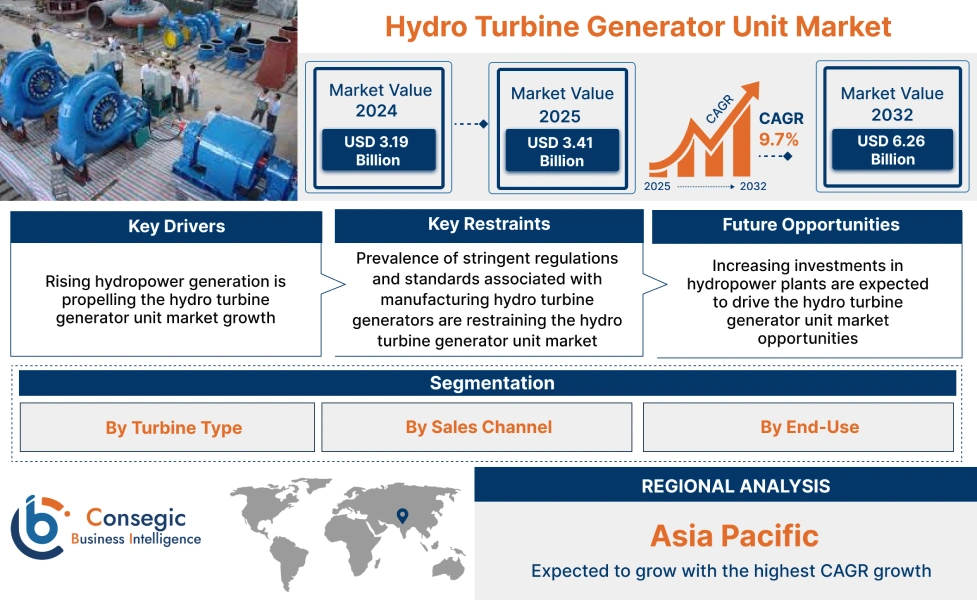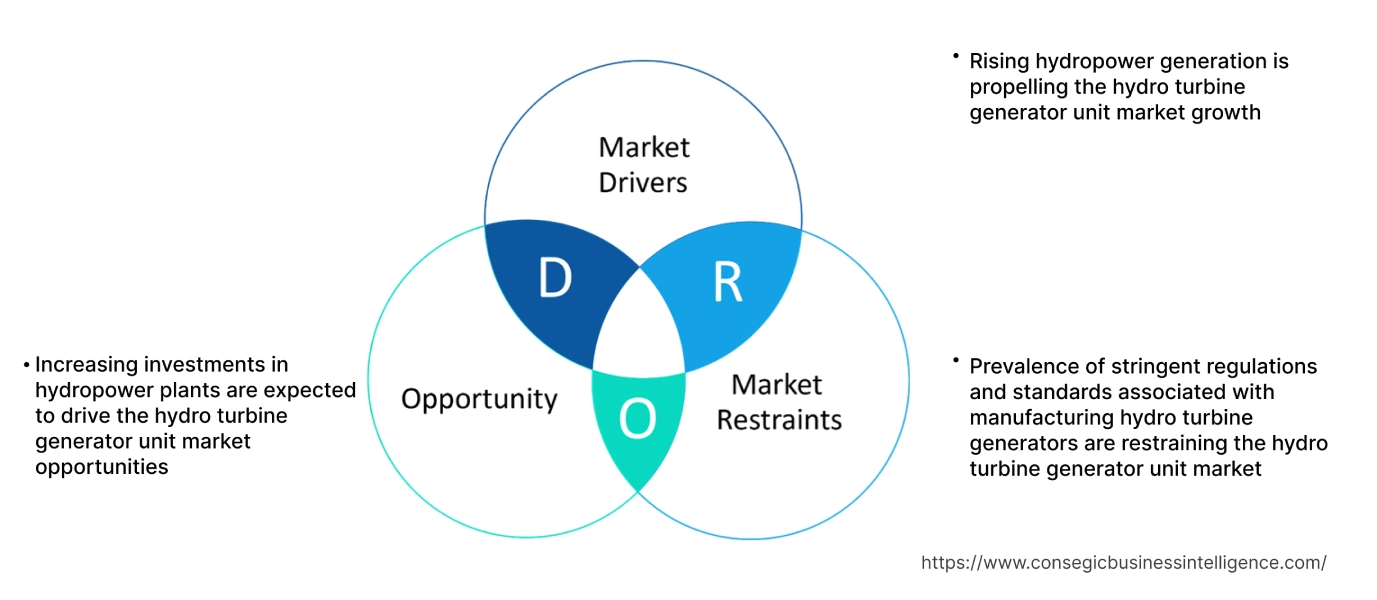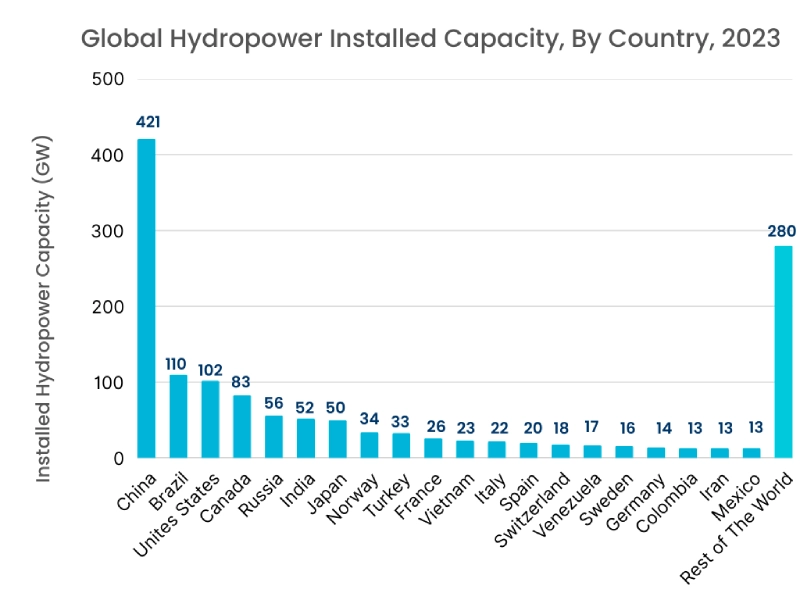Hydro Turbine Generator Unit Market Size:
Hydro Turbine Generator Unit Market size is estimated to reach over USD 6.26 Billion by 2032 from a value of USD 3.19 Billion in 2024 and is projected to grow by USD 3.41 Billion in 2025, growing at a CAGR of 9.7% from 2025 to 2032.
Hydro Turbine Generator Unit Market Scope & Overview:
Hydro turbine generator unit refers to a system that converts the kinetic and potential energy of flowing or falling water into mechanical energy, which is further transformed into electrical energy by using a generator. Moreover, the primary types of turbines that are typically used in hydropower plants incudes francis turbine, propeller/kaplan turbine, pelton turbine pelton, kinetic turbine, and others. Additionally, hydro turbine generator unit offer a broad range of benefits including durability, longer lifespan, low operating emissions, and flexible operations among others.
How AI is Impacting the Hydro Turbine Generator Unit Market?
AI is profoundly impacting the hydro turbine generator unit market by optimizing every stage from initial planning to ongoing operations. AI algorithms enhance hydrological forecasting, enabling more accurate predictions of water availability and improving reservoir management. During operation, AI-powered systems can fine-tune turbines and generator controls in real-time, maximizing energy output and efficiency while minimizing wear and tear. Furthermore, AI facilitates predictive maintenance, allowing for proactive repairs that reduce downtime and extend equipment lifespan. This integration of AI leads to more reliable, efficient, and cost-effective hydropower generation, ultimately bolstering its role in the global renewable energy mix.
Hydro Turbine Generator Unit Market Dynamics - (DRO) :
Key Drivers:
Rising hydropower generation is propelling the hydro turbine generator unit market growth
Hydro turbine generator unit plays a vital role in hydropower generation for transforming the energy from flowing water into electrical energy. Moreover, the utilization of turbine generator unit in hydropower generation assists in achieving high efficiencies in converting water energy into electrical energy, which makes it one of the most efficient renewable energy sources. As a result, the rising hydropower generation is driving the market.
- For instance, according to the International Hydropower Association, the installed hydropower capacity reached 1,416 GW worldwide in 2023, among which countries such as China, Brazil, United States, Canada, Russia, and India were among the largest hydropower producing countries by installed capacity in 2023.
Thus, the rising hydropower generation is increasing the adoption of hydro turbine generators, in turn proliferating the hydro turbine generator unit market size.
Key Restraints:
Prevalence of stringent regulations and standards associated with manufacturing hydro turbine generators are restraining the hydro turbine generator unit market
The manufacturers of hydro turbine generator have to comply with various stringent standards such as ISO (International Organization for Standardization) standard, IEC (International Electrotechnical Commission) standard, CE (Conformite Européenne), and others.
ISO standard is among the primary standards that include ISO 9001 and ISO 14001, which apply to quality management and environmental management respectively. ISO standards provide a set of guidelines for hydro turbine generator manufacturers to establish levels of homogeneity in accordance with the management, provision of services, and product development in the industry.
Additionally, hydro turbine generator manufacturers must comply with IEC 61850 standard, which specifies and defines acceptance tests for hydro turbines, turbine runners, impellers, and others, while facilitating with the interoperation of hydropower plants with the grid. Furthermore, CE certification ensures that the hydro turbine generator manufacturer takes responsibility for the compliance of a product with all applicable to European health, performance safety, and environmental requirements. Therefore, the prevalence of aforementioned regulations and standards associated with manufacturing hydro turbine generators is limiting the hydro turbine generator unit market expansion.
Future Opportunities :
Increasing investments in hydropower plants are expected to drive the hydro turbine generator unit market opportunities
The growing concerns regarding climate change and increasing consumer preference for sustainable energy sources are increasing investments in renewable energy, including hydropower plants. Turbine generator units are primarily used in hydropower plants for converting the kinetic energy of flowing water into mechanical energy, which is further transformed into electrical energy by using a generator. As a result, increasing investments in hydropower plants are providing lucrative aspects for market growth.
- For instance, in January 2021, the Union Cabinet of India approved an investment of approximately USD 723.43 million in the 850-MW hydropower project, located on river Chenab in Jammu and Kashmir. The generated hydropower is expected to balance the grid and strengthen power supply.
Therefore, as per the analysis, rising investments in hydropower plants are projected to drive the hydro turbine generator unit market opportunities during the forecast period.
Hydro Turbine Generator Unit Market Segmental Analysis :
By Turbine Type:
Based on turbine type, the market is segmented into francis turbine, propeller/kaplan turbine, kinetic turbine, pelton turbine, and others.
Trends in the turbine type:
- Increasing trend in adoption of francis turbines in hydropower plants due to its high efficiency, smooth operation, and increased versatility.
- There is a rising trend towards utilization of propeller/kaplan turbines in low-head hydroelectric power plants, attributing to its variable flow adaptability, and high efficiency at low head applications.
The francis turbine segment accounted for the largest revenue share of 32.64% in the total hydro turbine generator unit market share in 2024.
- The francis turbine refers to a type of hydro turbine that operates on the principle of converting the kinetic energy of water into mechanical energy. It is type of inward flow reaction turbine, wherein both the pressure and kinetic energy of the water contribute to its operation.
- Moreover, francis turbines are ideal for medium-head installations and can operate efficiently over a wide range of flow conditions.
- Additionally, francis turbines offer several benefits such as high efficiency, compact design, smooth operation, and increased versatility among others.
- For instance, Kirloskar Brothers Limited offers francis turbines in its product offerings. KBL francis turbines are generally used for sites that have medium head and medium discharge.
- According to the hydro turbine generator unit market analysis, the rising advancements associated with francis turbines are driving the hydro turbine generator unit market trends.
Propeller/kaplan turbine segment is anticipated to register significant CAGR growth during the forecast period.
- Propeller/kaplan turbines are designed to convert the energy in flowing water into mechanical energy. It often features adjustable blades that enable the turbine to optimize its performance under numerous water flow conditions.
- Moreover, these turbines provide several benefits such as high efficiency at low head applications, variable flow adaptability, and improved ability to handle fluctuations in water flow among others.
- For instance, in September 2023, GE Vernova completed the upgradation of its first among six kaplan turbine and generator units at the Qairokkum hydropower plant located in Tajikistan.
- Therefore, the increasing adoption of propeller/kaplan turbines in hydropower plants are projected to drive the hydro turbine generator unit market growth during the forecast period.
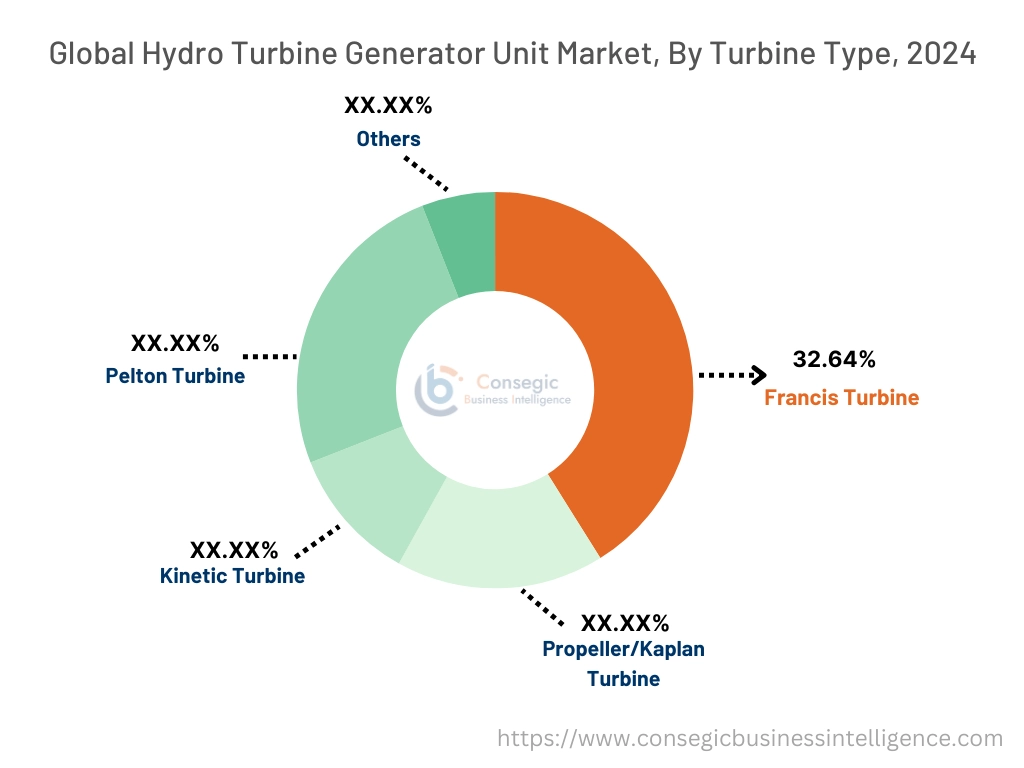
By End-Use:
Based on the end-use, the market is segmented into small hydropower plant, medium hydropower plant, and large hydropower plant.
Trends in the end-use:
- Factors including the growing demand for electricity, along with increasing need for clean and renewable source of energy are key trends propelling the growth of the segment.
- Rising adoption of advanced hydro turbine generator set in hydropower plants to ensure maximum efficiency and reliability in energy conversion and production is driving the market.
Large hydropower plant segment accounted for the largest revenue share in the overall hydro turbine generator unit market share in 2024, and it is anticipated to register substantial CAGR growth during the forecast period.
- Large hydropower plants refer to facilities that usually have a capacity of more than 30 megawatts (MW), while this capacity can vary depending on the country.
- Large hydropower plants typically utilize substantial water sources, such as large rivers or reservoirs, and are mainly designed for converting the energy from moving water into electricity on a large scale.
- Moreover, large hydropower plants can generate hundreds to thousands of megawatts, making them a prominent source of renewable energy.
- Additionally, large hydropower plants usually deploy highly efficient turbines that are ideal for various hydraulic conditions while the turbine generator set ensures maximum efficiency and reliability in energy conversion and production.
- For instance, in March 2024, the Indian government inaugurated the 2,880 MW multipurpose hydropower project, which is a large hydropower project, located in the Lower Dibang Valley district of Arunachal Pradesh, India. The project will generate 11,223 million units of hydropower each year, which will be fed into the northern grid.
- According to the analysis, the rising development of large hydroelectric power plant is driving the adoption of hydro turbine generators, in turn propelling the hydro turbine generator unit market size.
Regional Analysis:
The regions covered are North America, Europe, Asia Pacific, the Middle East and Africa, and Latin America.
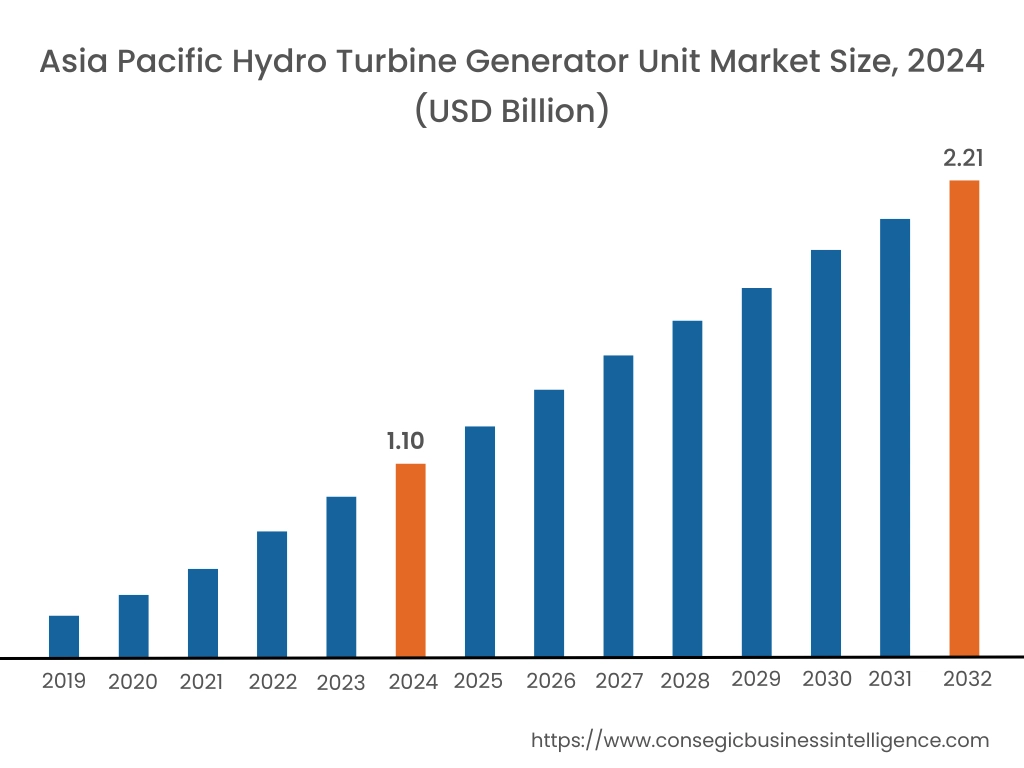
Asia Pacific region was valued at USD 1.10 Billion in 2024. Moreover, it is projected to grow by USD 1.18 Billion in 2025 and reach over USD 2.21 Billion by 2032. Out of this, China accounted for the maximum revenue share of 34.61%. As per the hydro turbine generator unit market analysis, the adoption of hydro turbine generators in the Asia-Pacific region is primarily driven by rising need for clean and sustainable sources for power generation and increasing government investments in hydropower projects among others. Additionally, the rising hydropower generation is further accelerating the hydro turbine generator unit market expansion.
- For instance, according to the International Hydropower Association, China completed the development of the Fengning Pumped Storage Power Station in August 2024, which is among the largest pumped hydropower plant in the world. The hydropower plant is situated in Hebei province of China, and has a total installed capacity of 3.6 GW. The above factors are further propelling the market demand in the Asia-Pacific region.
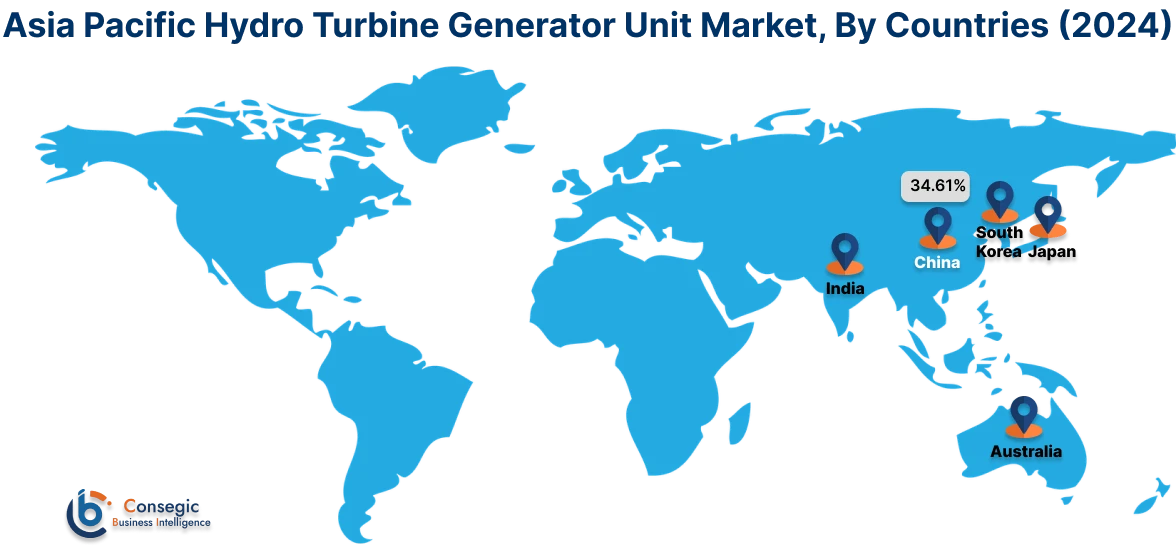
North America is estimated to reach over USD 1.65 Billion by 2032 from a value of USD 0.84 Billion in 2024 and is projected to grow by USD 0.89 Billion in 2025. In North America, the growth of hydro turbine generator unit industry is driven by increasing hydropower generation and growing adoption of hydro turbine generator sets in hydropower plants in the region. Similarly, rising government incentives and investments associated with hydroelectric facilities are further contributing to the hydro turbine generator unit market demand.
- For instance, in September 2024, the U.S. Department of Energy (DOE) allocated USD 430 million for modernizing 293 hydroelectric facilities across 33 U.S. states. Thus, the aforementioned factors are expected to drive the hydro turbine generator unit market trends in North America during the forecast period.
In addition, the regional analysis depicts that the growing need for sustainable energy, favorable government measures for adoption of renewable energy source, and rising development of hydropower plants are propelling the hydro turbine generator unit market demand in Europe. Further, according to the analysis, the market demand in Latin America, Middle East, and African regions is projected to grow at a substantial rate due to factors such as rising need for sustainable source of electricity, growing hydropower generation, and increasing investments in development of hydroelectric power plants among others.
Top Key Players and Market Share Insights:
The global hydro turbine generator unit market is highly competitive with major players providing products to the national and international markets. Key players are adopting several strategies in research and development (R&D), product innovation, and end-user launches to hold a strong position in the hydro turbine generator unit market. Key players in the hydro turbine generator unit industry include-
- ANDRITZ (Austria)
- GE Vernova Inc. (U.S)
- Toshiba (Japan)
- Canyon Hydro (U.S)
- Mitsubishi Heavy Industries Ltd. (Japan)
- Bharat Heavy Electricals Limited (India)
- Harbin Electric (China)
- Power Machines (Russia)
- IMPSA (Argentina)
- WWS Wasserkraft GmbH (Austria)
- Kirloskar Brothers Limited (India)
Hydro Turbine Generator Unit Market Ecosystem:
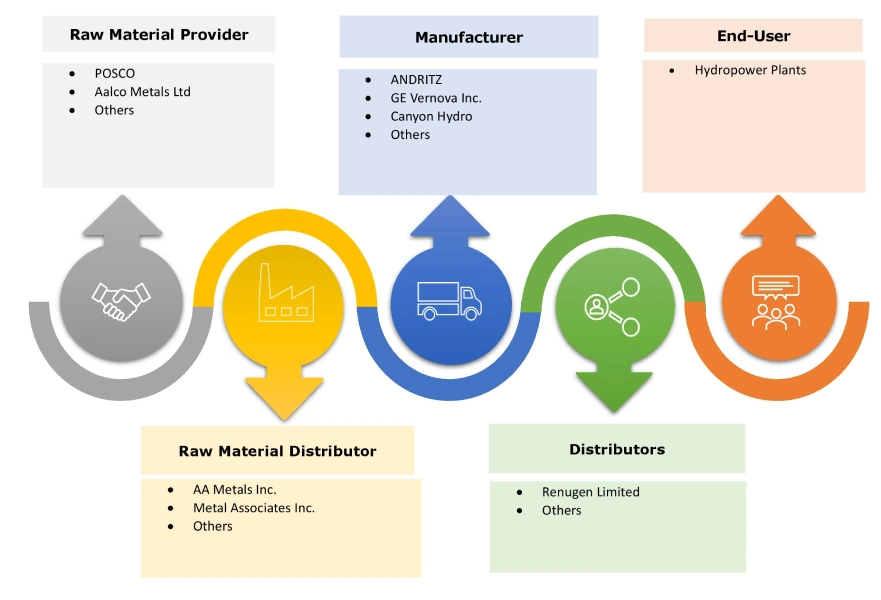
Recent Industry Developments :
Business Agreement:
- In June 2024, Devlet Su İşleri (DSI), the Turkish water authority, selected ANDRITZ Group for supplying four 40 MW turbines, four generators, along with related hydropower plant equipment for its new 160 MW Silvan hydropower plant located in Turkey.
Hydro Turbine Generator Unit Market Report Insights :
| Report Attributes | Report Details |
| Study Timeline | 2019-2032 |
| Market Size in 2032 | USD 6.26 Billion |
| CAGR (2025-2032) | 9.7% |
| By Turbine Type |
|
| By Sales Channel |
|
| By End-Use |
|
| By Region |
|
| Key Players |
|
| North America | U.S. Canada Mexico |
| Europe | U.K. Germany France Spain Italy Russia Benelux Rest of Europe |
| APAC | China South Korea Japan India Australia ASEAN Rest of Asia-Pacific |
| Middle East and Africa | GCC Turkey South Africa Rest of MEA |
| LATAM | Brazil Argentina Chile Rest of LATAM |
| Report Coverage |
|
Key Questions Answered in the Report
How big is the hydro turbine generator unit market? +
The hydro turbine generator unit market was valued at USD 3.19 Billion in 2024 and is projected to grow to USD 6.26 Billion by 2032.
Which is the fastest-growing region in the hydro turbine generator unit market? +
Asia-Pacific is the region experiencing the most rapid growth in the hydro turbine generator unit market.
What specific segmentation details are covered in the hydro turbine generator unit report? +
The hydro turbine generator unit report includes specific segmentation details for turbine type, sales channel, end-use, and region.
Who are the major players in the hydro turbine generator unit market? +
The key participants in the hydro turbine generator unit market are ANDRITZ (Austria), GE Vernova Inc. (U.S), Toshiba (Japan), Canyon Hydro (U.S), Mitsubishi Heavy Industries Ltd. (Japan), Bharat Heavy Electricals Limited (India), Harbin Electric (China), Power Machines (Russia), IMPSA (Argentina), WWS Wasserkraft GmbH (Austria), Kirloskar Brothers Limited (India), and others.
